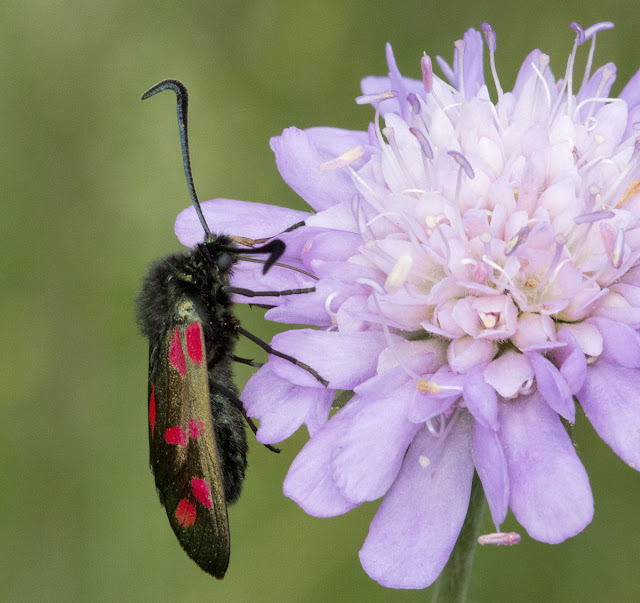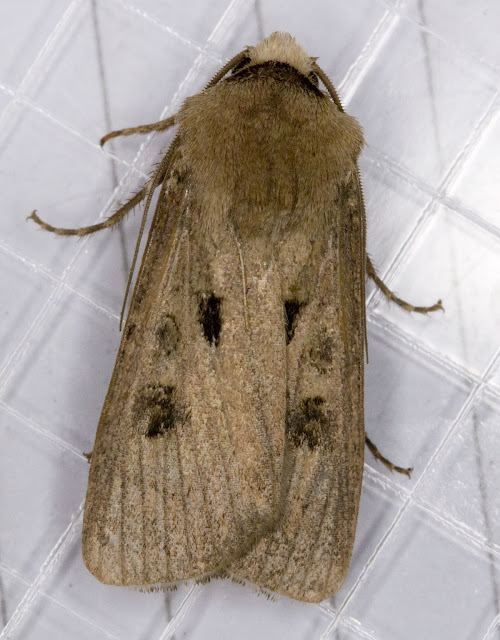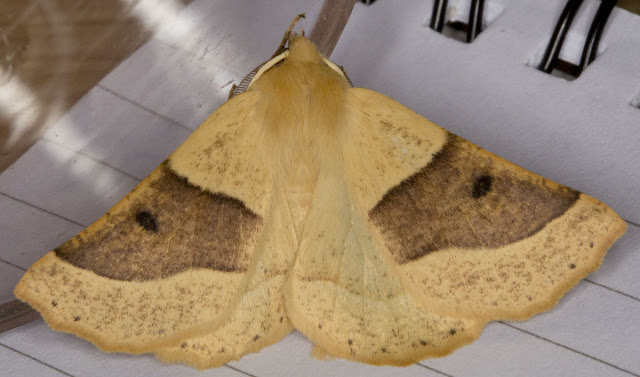 |
| Hoverfly laying an egg on the underside of a hawthorn leaf in the back garden of my house in Hayes. 27 July 2011. |
Sunday 31 July 2011
Hoverfly Laying
Saturday 30 July 2011
Coney Hall to Spring Park
 |
| Dappled sunlight on the path through the woods of Spring Park 29 July 2011. |
There were ten of us, including Stephen Tickner from Bromley, who led the walk. The job titles in the Countryside Service have all been changed during their reorganisation, and Stephen is a Principal Countryside Development Officer.
This walk was planned by Ewa Prokop, who has left, but Stephen did a good job of showing us round. There are still a few of Ewa's walks to come; the events planned in the current leaflet run up to the end of September.
We started at Coney Hall recreation ground and walked past St. John's Church and over the fields. It was hazy, but warm, and the countryside was pleasant and green. We paused at some hedgerows to look at the flowers and insect life. Some of the fields were set to grass, one was full of ripening wheat. At the bottom of the slope we crossed a busy road, called locally the Mad Mile, and went up to Spring Park's pond.
 |
| Plant life at the edge of the wood by the pond in Spring Park. 29 July 2011. |
The second photo shows a typical slice of the plant life between the pond and the wood. You could find something like this anywhere in England. Included here are grasses, some with seed heads; white clover in the foreground; ripening blackberries and many bramble leaves; dock leaves; and some Creeping Thistles, one of which is flowering. To some, this might look like a patch of weeds, but these are all useful plants in their context. A Gatekeeper butterfly is basking on a dock leaf.
During the walk, as well as Gatekeepers, we saw a couple of Meadow Browns, some large and small Whites, and in the woods, a pair of Speckled Browns flying round and round each other, then away into the trees. Not very many for such a warm day, but it was good to see them.
We walked up the slope, through the woodland along abroad main pathway, and then back to the start point.
Labels:
City Commons,
insects,
invertebrates,
mini-beasts,
Spring Park,
walks
Friday 29 July 2011
Glow-Worms
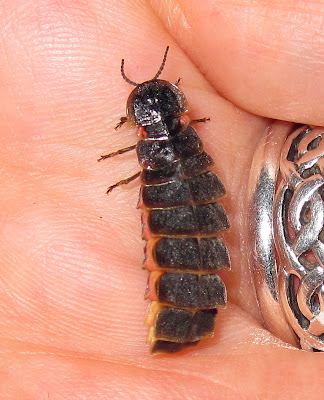 |
| Glow-worm, Lampyris noctiluca, female adult. High Elms Country Park, 27 July 2011. |
We walked along the paths through the woods and suddenly, there was a tiny distinct green glow not far away. The walk leader, Alison, a local volunteer and glow-worm fan, picked it up and we all had a good look.
I wasn't equipped to capture the glow, which really needs a tripod and a long exposure. This is a flash photo with my little Ixus 100. But you can see a slightly different colour in the end two segments, and that's where the glow comes from.
This type of glow-worm doesn't fly, but sits on or near the ground in an exposed spot and waits for the males to fly to her.
We carried on through the woods and along the edges of High Elms' meadows and glades, and saw six more of the bright specks. I was surprised to find them all in woodland; I had thought they only lived in open meadows. But, glow-worms! I was very pleased.
Thursday 28 July 2011
Wednesday 27 July 2011
Six Spot Burnet
Labels:
flowers,
High Elms,
insects,
invertebrates,
mini-beasts,
moths
Tuesday 26 July 2011
Rest-Harrow
Labels:
City Commons,
flowers,
plants,
Riddlesdown
Location:
Unknown location.
Monday 25 July 2011
Sunday 24 July 2011
Darrick Wood Butterflies
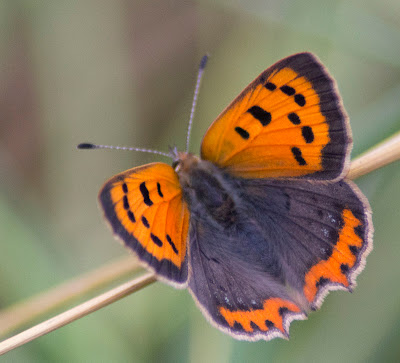 |
| Small Copper, Lycaena phlaeas. Darrick and Newstead Woods, 23 July 2011. |
There was only intermittent sunshine, but it warmed up a little as we went along. It was a good group, containing many of the Friends of Jubilee Country Park, and some faces I recognised from other groups, including Keith who led a Scadbury Park walk a few days ago.
The paths through the woods were very quiet and quite dark. But when we emerged into a meadow everything changed. They were full of colourful flowers, and soon we began to see butterflies.
One thing that struck me was that the people on this walk were focused. Butterflies were what the walk was for, and that's what they had come to see. Walking with, for example, the Orpington Field Club, everything was of interest to somebody. Here, there was only occasional interest in plants and other invertebrates.
 |
| Something different: a fly, Tachina fera, on Creeping Thistle, Cirsium arvense. Darrick and Newstead Woods, 23 July 2011. |
Several of us were checking out all the Ragworts we passed, to see if there were any Cinnabar caterpillars on them. There were none, in great contrast to Scadbury Park three days ago where they swarmed on almost every plant. I have also seen them on the Four Corners section of the Hayes Common SSSI.
At the end of the walk, Sue had a count of 53 butterflies of 8 species. That's not outstanding, but it's not bad for an unpromising day.
At the time I wasn't counting, but thinking back, I had seen many nice fresh Gatekeepers and tired Meadow Browns, an older Ringlet, an outstanding Small Copper, some Large Whites and a Green-Veined White, some Commas, some Small and Essex Skippers, a Small Heath, one very nice Brown Argus, a Speckled Wood, and a blue, probably a Common Blue, that flew away from us just as we were coming to the end of the walk. I make that 12 species, allowing for the fact that Small and Essex Skippers are counted together because they are so hard to distinguish. I do not know why Sue only had eight on her list.
I was using my EOS 60D with a 200mm lens and 2x extender again. This time I was trying a faster shutter speed, which successfully eliminated camera shake, but resulted in a smaller depth of field, more so when the sun was behind the clouds. Always there is a tradeoff .. I will try something different again next time, perhaps a higher ISO.
 |
| Gatekeeper, Pyronia tithonus. Butterfly walk in Darrick and Newstead Woods, 23 July 2011. You can clearly see the two white spots that distinguish this from a Meadow Brown, which has one white spot. |
 |
| Ringlet, Aphantopus hyperantus; rather faded. Butterfly walk in Darrick and Newstead Woods, 23 July 2011. Compare this with the fresh specimen in my post on Downe Bank a month ago. |
 |
| Green-Veined White, Pieris napi. Butterfly walk in Darrick and Newstead Woods, 23 July 2011. |
 |
| Finally, a longhorn beetle, Strangalia maculata, on Hogweed, Heracleum sphondylium. Butterfly walk in Darrick and Newstead Woods, 23 July 2011. |
Labels:
butterflies,
Darrick Wood,
insects,
invertebrates,
mini-beasts
Saturday 23 July 2011
Light Emerald
 |
| Light Emerald moth, Campaea margaritata. Flew across Saville Row on the morning of 20 July 2011. |
I wasn't sure I could, though. I can see the signs of my inexperience. I have failed to identify several moths that I have good clear photos of.
When I was writing machine code for the ZX Spectrum, if a sequence failed to work as expected it was very tempting to say that there was an error in the manual, or an undocumented effect. But there never was. It was always an error in my code or my understanding of it. In the same way, it is tempting to say that all those moths I can't identify must be micromoths, and therefore not in my book, which doesn't cover those. And some of them might be, but I am pretty sure that others are actually in there somewhere, as yet unrecognised by me.
I thought I recognised this one as one of the "Waves" but when I looked them up, the banding on their wings was darker than the background, not lighter. But on the same page was a Light Emerald. This moth does have a slight greenish tint, which I thought at first was because of the green leaves it is resting among. The Light Emerald's description says "fading to whitish" and as this specimen is damaged, it could well be old. And the Light Emerald, I suddenly realised, has one fewer wing band than the Waves, and so does my specimen.
The diagram in my book, the widely used "Concise Guide to the Moths of Great Britain and Northern Ireland," shows the Light Emerald's bands as having both a light and a dark component. My specimen does not show that. The lower band on the forewing should match up with the single band on the hindwing. On this one, it does not. And the description on the UKmoths site mentions a blood-red tip to the forewing, which mine does not seem to have either. But moths do vary a lot; the experts say they haven't read the books.
I could still be wrong, of course. I don't yet now which features are critical and don't change, and which are mutable, either generally or with age. Moths are tricky.
Friday 22 July 2011
Holly Blue
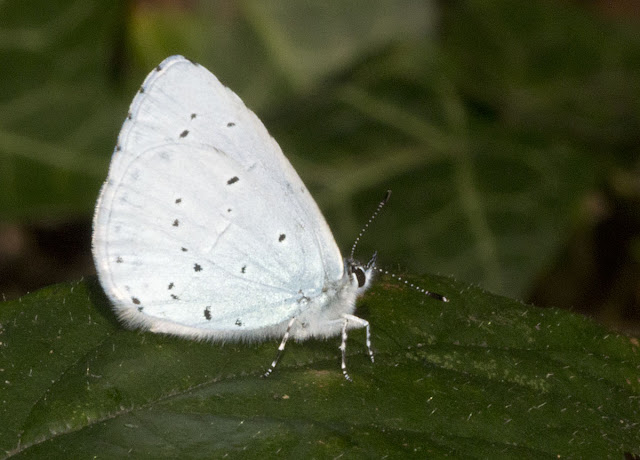 |
| Holly Blue butterfly, Celastrina argiolus, side view, by the roadside in Hayes Common, 11 July 2011. |
I haven't been keeping species counts as some people do, but I know I have seen many more types of butterfly over the last month than I ever have before.
Labels:
butterflies,
Hayes Common,
insects,
invertebrates,
mini-beasts
Location:
Unknown location.
Thursday 21 July 2011
Scadbury Park Ladybirds
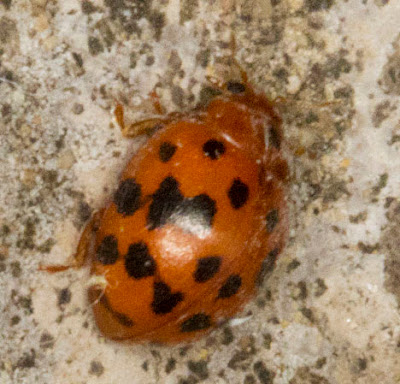 |
| 24-Spot Ladybird, Subcoccinella 24-punctata. Scadbury Park, 20 July 2011. |
It was led by a local volunteer, and we walked through a meadow to a hedgerow, where we shook the branches over an upturned umbrella to see what fell in. Mostly, this was small insects, spiders, woodlice and earwigs. This tiny 24-spot ladybird was among them, as was the small spider below, with its interesting reticulated patterning. You can see the umbrella background in the photo of the spider.
But of course there were many more insects around, bigger ones too. There were a few other ladybirds, including several large and healthy 7-spots. Bees, wasps, flies and beetles were visiting the flowers, and also butterflies, of course; Meadow Browns and Gatekeepers, and there were some Commas in the bramble scrub by the hedge.
Ragworts were scattered all through the meadow, and many of them were being thoroughly consumed by vivid (and poisonous) caterpillars of the Cinnabar moth. Back among in the brambles I found some snails and a tortoise bug, a close relation of the shield bugs. A little moth fluttered down and stayed long enough to be photographed. It ooks like a smear of bird dropping if you stand back, but it's colourful close to. I haven't identified it, despite having a good book on macromoths now, so either it's a micromoth species or I am still terrible at moth identification. Either or both of these could be true.
 |
| Unidentified bee, looks like an Andrena species, foraging in a thistle flower. Ladybird walk in Scadbury Park, 20 July 2011. |
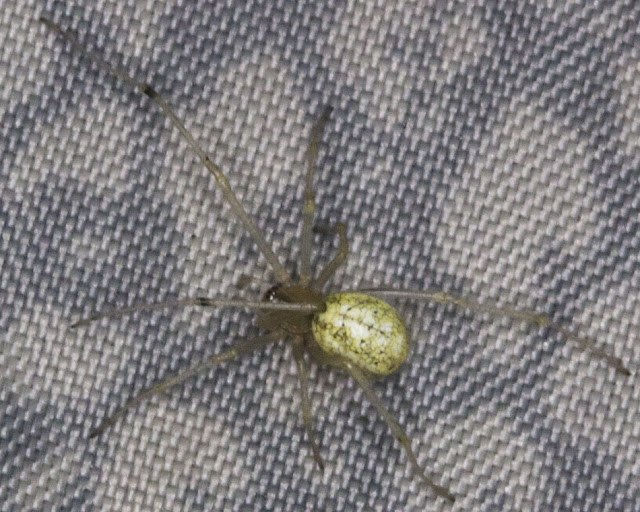 |
| Unidentified spider in an umbrella. Ladybird walk in Scadbury Park, 20 July 2011. |
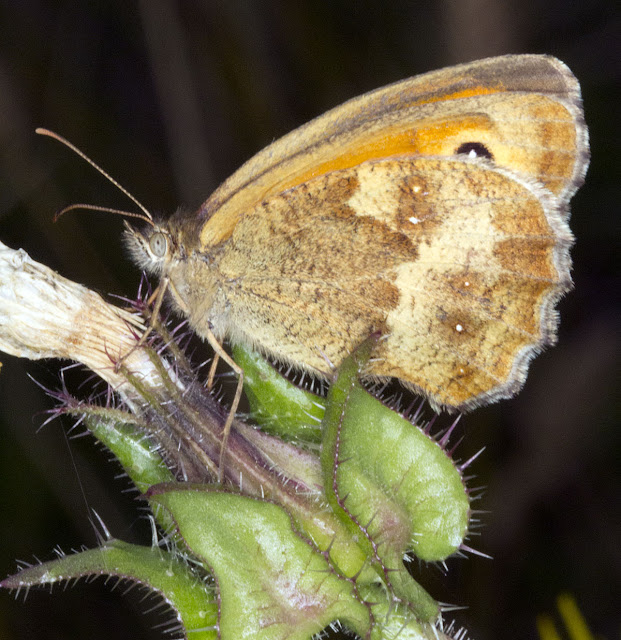 |
| Gatekeeper butterfly, Pyronia tithonus. Ladybird walk in Scadbury Park, 20 July 2011. |
 |
| Tortoise bug, Eurygaster testudinaria. Ladybird walk in Scadbury Park, 20 July 2011. |
 |
| Unidentified moth imitating a bird dropping. Ladybird walk in Scadbury Park, 20 July 2011. |
 |
| Cinnabar Moth caterpillars, Tyria jacobaeae, an Arctiid, on Common Ragwort, Senecio jacobaea. Ladybird walk in Scadbury Park, 20 July 2011. |
Labels:
butterflies,
insects,
invertebrates,
mini-beasts,
moths,
Scadbury Park,
spiders
Wednesday 20 July 2011
Farthing Downs Moths
moth and butterfly day at Farthing Downs. The backgrounds are not up to much, but the moths are mostly pretty clear.
The Noctuids were happy to be photographed with the lids off their jars. The geometers were more excitable, and the Small Waved Umber above was photographed on a wall (actually, a window in an interior wall). Gill recaptured it so that it could be released into the wild, rather than remain trapped in the office.
The Noctuids were happy to be photographed with the lids off their jars. The geometers were more excitable, and the Small Waved Umber above was photographed on a wall (actually, a window in an interior wall). Gill recaptured it so that it could be released into the wild, rather than remain trapped in the office.
 |
| Clay moth, Mythimna ferrago. Male. A Noctuid. From a moth trap on Farthing Downs on the night of 16th July 2011. Moths and Butterflies on Farthing Downs, with Gill Peachey. Photographed the next day. |
Labels:
City Commons,
Farthing Downs,
insects,
invertebrates,
mini-beasts,
moths
Location:
Unknown location.
Tuesday 19 July 2011
Oedemera Nobilis Female
 |
| Oedemera nobilis female on Hayes Common, 27 May 2011. |
Labels:
Hayes Common,
insects,
invertebrates,
mini-beasts
Location:
Unknown location.
Monday 18 July 2011
Butterfly Season
 |
| Purple Hairstreak, Neozephyrus quercus, in an oak tree. Jubilee Country Park, Sunday 17th July 2011. |
The walk at JCP was led by Marcus Jordan and Tony Ruffle. The forecast was for heavy showers, but we had good sunshine for over an hour. To begin with, no butterflies were apparent. Perhaps we were a little early. But we spread out and walked through the meadows; there were perhaps a dozen of us, and we flushed out several; then quite soon there were lots flying around.
These were Meadow Browns and Ringlets, a few fresh bright Gatekeepers, and we also saw a few small Skippers. One of them was confirmed as an Essex Skipper. You can only tell this from a Small Skipper by examining the underside of its antennae. An Essex Skipper's antennae are black beneath; a Small Skipper's are not. Of course, usually you see them from above ...
 |
| Essex Skipper, Thymelicus lineola. Jubilee Country Park, Sunday 17th July 2011. |
I haven't included photos of species I posted earlier this week, except for the Comma. I had one shot of the Comma I could not resist posting. There were other creatures, too; bumblebees, beetles, hoverflies, and we saw a Five-Spot Burnet moth.
Then it started to rain. Butterflies do not fly in the rain.
So in the afternoon I went to Farthing Downs. This is a City of London Common and the walk was led by a local volunteer, Gill Peachey. Perhaps because of the weather, I was the only one to turn up for the walk, though there were other visitors in the car park; what can keep people from such good quality free entertainment? I do not understand it.
 |
| Ringlet, Aphantopus hyperantus, looking rather tattered. Jubilee Country Park, Sunday 17th July 2011. |
We went out for a look around the common. We had maybe half an hour of clear weather, during which we saw a Small Copper, a Small Heath and a Green-Veined White along with the expected Meadow Browns. Then it began to rain quite hard, and didn't stop. The camera went into my bag and my umbrella protected that rather than me. But Gill is pretty good at plants as well as lepidoptera, and now I know where to come for some bee and fly orchids next year.
All today's butterfly photos were taken with the 200mm prime lens and 2x extension tube on my EOS 60D. I need to use an even shorter exposure in future, because despite my care, some of these are slightly blurry. You can see from the really sharp ones, like that comma, what the lens can do.
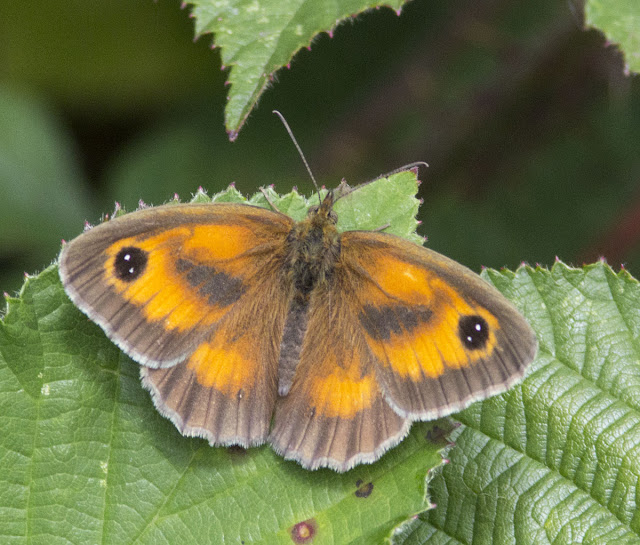 |
| Gatekeeper, Pyronia tithonus. Butterfly walk in Jubilee Country Park, Sunday 17th July 2011. |
 |
| Comma, Polygonia c-album. Butterfly walk in Jubilee Country Park, Sunday 17th July 2011. |
 |
| Small Heath, Coenonympha pamphylus. Moths and Butterflies on Farthing Downs, Sunday 17th July 2011. |
| Green-Veined White, Pieris napi. Moths and Butterflies on Farthing Downs, Sunday 17th July 2011. |
 |
| Small Copper, Lycaena phlaeas. Moths and Butterflies on Farthing Downs, Sunday 17th July 2011. |
Labels:
butterflies,
City Commons,
Farthing Downs,
insects,
invertebrates,
Jubilee Country Park,
mini-beasts
Location:
Unknown location.
Sunday 17 July 2011
Cherub Heads
 |
| Cherub heads from the 1705 "Smith" organ case in St. David's Cathedral (Eglwys Gadeiriol Tyddewi), St. David's (Tyddewi), Pembrokeshire. 8 July 2011. |
Labels:
sculpture,
St David's,
Wales
Location:
Unknown location.
Saturday 16 July 2011
Better Butterflies
 |
| Meadow Brown butterfly, Maniola jurtina. 15 July 2011. |
The forecast was accurate, mostly, and it was warmer and sunnier, and more butterflies appeared. As I did not have to dash after a group, and there were fewer feet to disturb the surroundings, I got some better photos; some of the same butterflies as yesterday, some of new ones.
The gaudy Peacock and the pleasant Brimstone shown below did not appear yesterday. But my favourite pics today were those of the Silver-Washed Fritillary, which I have saved for last below. I have included a close-up which shows the full potential of the macro lens; click on the photos to see the full effect.
On the way round I met for the first time the gentleman who blogs as Greenie In The Wild. I am surprised not to have come across him before, because we have several wildlife areas in common and we live not far apart. He certainly knows High Elms well, and he showed me some interesting spots and some bee orchids, for which, thanks. I also came across the BCS ranger for the area, Terry Jones, who led yesterday's walk, and who won't be there for much longer. He knows the place even better, if possible.
These photos were taken with the EOS 60D. For some, like the Fritillary, I used the 100mm macro lens; sometimes with a Kenko 1.4x extender. (Not Kenco, which is coffee.) For others, like the meadow Brown above, I used a 200mm prime lens with a 2x extender. This long focal length is tricky hand-held and some of these shots could be sharper, but with shy or inaccessible butterflies the alternative would be even worse. There were actually lots of Meadow Browns around, but almost all of them were old and faded.
 |
| Comma butterfly, Polygonium c-album, near the Conservation Field in High Elms Country Park, 15 July 2011. |
 |
| Small White butterfly, Pieris rapae, on Rough Hawkbit, Leontodon hispidus, in the Conservation Field in High Elms Country Park, 15 July 2011. |
 |
| Peacock butterfly, Inachis io, on Rough Hawkbit, Leontodon hispidus, in Burnt Gorse in High Elms Country Park, 15 July 2011. |
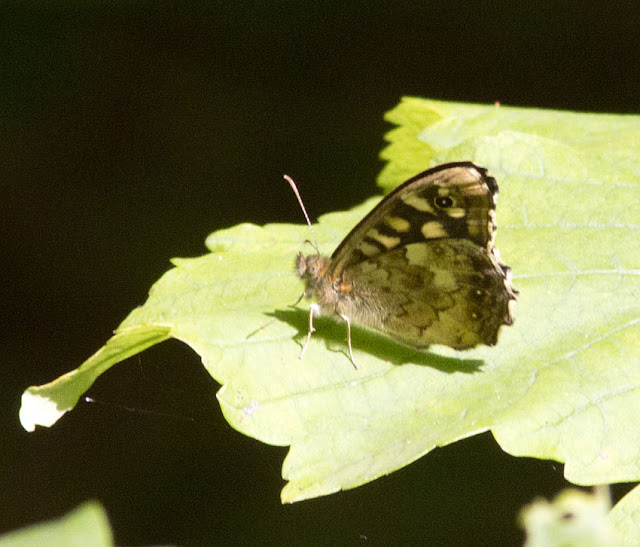 |
| Specked Wood butterfly, Pararge aegeria, in a glade in High Elms Country Park, 15 July 2011. |
 |
| Brimstone butterfly, Gonepteryx rhamni, on Pyramidal Orchid, Anacamptis pyramidalis, in Burnt Gorse in High Elms Country Park, 15 July 2011. |
 |
| Silver-Washed Fritillary, Argynnis paphia, on Rough Hawkbit, Leontodon hispidus, in Burnt Gorse in High Elms Country Park, 15 July 2011. |
 |
| Silver-Washed Fritillary, Argynnis paphia, on Rough Hawkbit, Leontodon hispidus, in Burnt Gorse in High Elms Country Park, 15 July 2011. |
Labels:
butterflies,
flowers,
High Elms,
insects,
invertebrates,
mini-beasts
Location:
Unknown location.
Friday 15 July 2011
High Elms Butterflies
 |
| Comma butterfly, Polygonium c-alba, on Hogweed, Heracleum sphondylium. 14 July 2011. |
However, many of them were at a distance and quite shy, so I only have a few slightly blurred crops of the more colourful ones. But I did get some very nice shots of other insects, that were less inclined to run away when I approached.
A fair-sized group of people followed Terry round the likely spots in High Elms Country Park. The grazed field, Burnt Gorse, the Orchid Bank, some of the woods, around the edge of the golf course. We saw quite a few Meadow Browns, Small Skippers, Large Whites and Ringlets. The first of the less usual ones was a showy Comma, high on a lush Hogweed. Then a Fritillary flew purposefully right across our field of view.
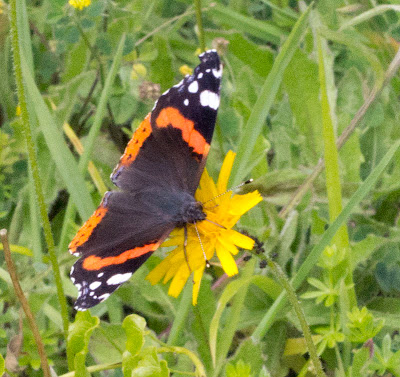 |
| Red Admiral butterfly, Vanessa atalanta. 14 July 2011. |
On Burnt Gorse we saw another Fritillary that actually rested for a while. On the Orchid Bank was a Red Admiral. I saw another Comma there, too. But there were much fewer of these than there might have been it it had been warmer and brighter. Terry had seen a White-Letter Hairstreak around a stand of Rosebay WIllowherbs on the Orchid Bank, but there was no sign of one today.
But he did point out some crab spiders on the same Willowherbs, and I saw quite a few hoverflies, wasps, grasshoppers and other invertebrates.
These photos were taken with my EOS 60D and 100mm macro lens, sometimes with a 1.4x Kenko Teleplus Pro extender.
 |
| Silver-Washed Fritillary, Argynnis paphia, on Burnt Gorse. Butterfly walk at High Elms Country Park, 14 July 2011. |
 |
| Honey bee, Apis mellifera, drinking nectar from White Melilot, Melilotus albus, on Burnt Gorse. Butterfly walk at High Elms Country Park, 14 July 2011. |
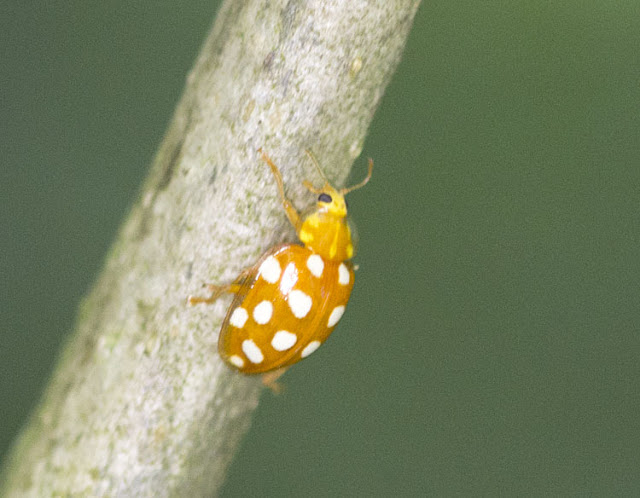 |
| Orange Ladybird, Halyzia sedecimguttata, in a tree at the edge of the golf course. Butterfly walk at High Elms Country Park, 14 July 2011. |
 |
| Common Wasp, Vespula vulgaris, on Hogweed, Heracleum sphondylium. High Elms Country Park, 14 July 2011. The small insect hitching a lift on its wing looks like an aphid. |
Labels:
butterflies,
High Elms,
insects,
invertebrates,
mini-beasts,
walks
Location:
Unknown location.
Thursday 14 July 2011
Forest Bug
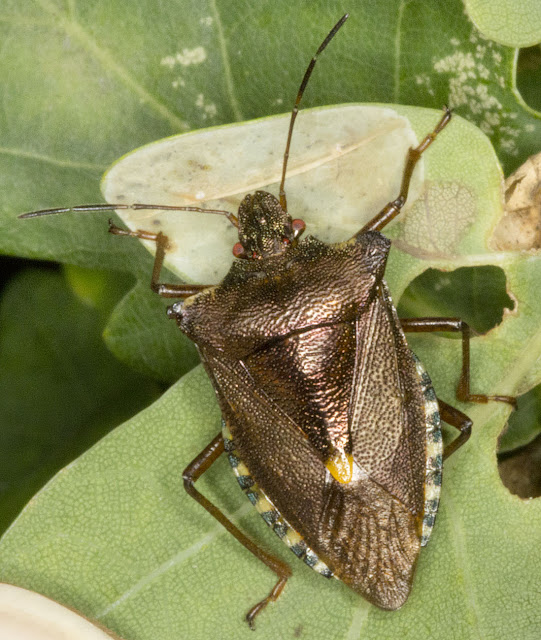 |
| Adult Forest Bug, Pentatoma rufipes, on an oak tree in Hayes Common, 11 July 2011. |
 |
| Final instar nymph of the Forest Bug, Pentatoma rufipes, on oak. Hayes Common, 24 June 2011. |
 |
| Mid instar nymph of the Forest Bug, Pentatoma rufipes, on beech leaf. Hayes Common, 18 May 2011. |
Labels:
Hayes Common,
insects,
invertebrates,
mini-beasts
Location:
Unknown location.
Subscribe to:
Posts (Atom)

